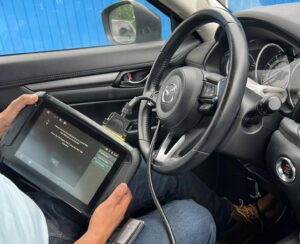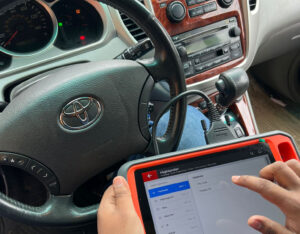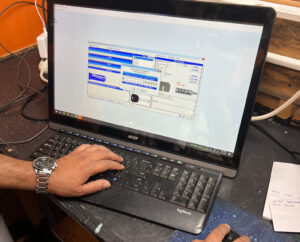Getting locked out of your car can feel frustrating, stressful, and even scary, especially when you’re in a hurry. Modern cars are packed with smart tech, but when that tech fails or you lose your keys, it doesn’t feel so smart anymore. The good news? Emergency car locksmiths know exactly how to get you back in without damaging your vehicle.
In this blog, we’ll break down how professional locksmiths unlock modern cars, why DIY methods can go wrong, and what steps you should take before and after the unlock. Whether it’s a stuck key fob, a locked trunk, or a jammed door, we’ve got clear answers to help you stay calm and make the right move.
Why Unlocking Modern Cars Is Different (and Tricky)

Modern vehicles are built to keep thieves out—but that also makes it harder for you to get in when something goes wrong. Unlike older models, today’s cars use smart key systems, keyless entry, and transponders that rely on synced signals, software, and sealed locking mechanisms.
- Smart Key Systems
Modern cars often don’t use traditional keys at all. Instead, they rely on encrypted chips that communicate with the car wirelessly. - Keyless Entry Confusion
Sometimes, the keyless entry system doesn’t respond, especially if the key fob battery is low or there’s interference nearby. - Anti-Theft Locking Mechanisms
Vehicles today have built-in anti-theft features that automatically disable door access when tampered with, even unintentionally. - Hidden or Sealed Keyholes
Some cars hide the keyhole completely behind a trim piece, making manual unlocking hard without knowing exactly where to look. - Transponder Pairing Issues
If the transponder chip in your key isn’t paired correctly or gets deprogrammed, your car won’t respond—even if the key physically fits. - Integrated Computer Modules
The locking system is often tied to the car’s onboard computer, meaning a wrong move can affect more than just the doors.
Why DIY Unlocking Can Go Wrong
Trying to unlock your car with a coat hanger or screwdriver might seem clever in the moment, but it often ends in regret. These DIY methods can easily bend your door frame, scratch paint, or damage internal wiring you can’t even see.
Modern cars are built with tightly integrated locking mechanisms and sometimes even side airbags inside the door. Poking around blindly risks triggering sensors, cracking trim, or jamming the keyhole entirely. Worse, using tools to “break into” your car may raise eyebrows legally if you’re spotted doing it. It’s not just risky—it could get expensive or embarrassing fast.
When to Call an Emergency Car Locksmith
There are moments when waiting or trying to fix things yourself just isn’t safe. If you’re dealing with a true lockout situation, calling an emergency car locksmith isn’t just smart—it’s necessary. Acting quickly protects your vehicle, your loved ones, and your peace of mind.
Whether your engine is running, your key fob won’t respond, or it’s the middle of the night, a professional emergency car locksmith can handle it safely and fast, without damaging your car or wasting your time.
- Child or Pet Locked Inside
This is always an emergency. Call for help immediately—don’t wait or try to fix it yourself. - Car Running but You’re Locked Out
Time matters. A running engine and a locked door are a costly and risky combo. - Key Fob Not Working at All
When your smart key fails and there’s no manual option, it’s time for expert tools and diagnostics. - Nighttime or Remote Lockout
Dark roads or unsafe areas are no place to be stuck alone. Call a trusted emergency locksmith now. - You’re Unsure What’s Wrong
If the lock isn’t jammed but nothing works, guessing can lead to damage. Let a pro assess it. - DIY Didn’t Work—or Made Things Worse
Tried a hanger or pry tool and got nowhere. A professional locksmith can still undo the mess safely.
Step-by-Step: How Professionals Unlock Cars Without Damage
Unlocking a modern car isn’t about luck or guesswork—it’s about knowing what to do and doing it with care. A trained automotive locksmith follows a clear process: assess the situation, choose the safest method, and unlock the car without leaving a scratch. Here’s how it works.
Non-Destructive Entry Techniques
The first option is always the safest one. Locksmiths use non-destructive tools like a slim jim, air wedge, or long probe rod to slide through small openings and trigger the locking mechanism—all without touching your paint or damaging the door frame.
- A slim Jim slips between the window and the weather stripping to lift the lock
- An air wedge creates a safe space between the door and the frame
- Probe tools reach inside to pull the latch or push buttons
- No broken parts, no force—just the right tools for the job
Smart Key & Fob Reprogramming
Sometimes the lock isn’t stuck—your key fob just isn’t talking to the car. When that happens, a locksmith checks for signal issues, low batteries, or programming glitches. If needed, they’ll re-sync the smart key using onboard diagnostics or a mobile scanner.
- Diagnoses dead or misfiring transponder chips
- Replace FOB batteries on-site if needed
- Reprograms your keyless entry system safely
- Avoids unnecessary replacements or dealer delays
Manual Lock Mechanism Handling
If electronics fail entirely, locksmiths go back to basics. Using lock-picking tools, they carefully work the keyway or lock cylinder to release the locking mechanism—no drilling or damage involved. This is delicate work that requires real expertise.
- Picks the lock using a torsion wrench and tools
- Uses a bump key only when appropriate and safe
- Adjusts or repairs a stuck locking mechanism
- Avoids breaking the lock, saving you replacement costs
Each method is chosen carefully, based on your car’s model, condition, and lock type. That’s how professional locksmiths get the job done—fast, clean, and without damage.
How Locksmiths Prevent Damage (Their Safety Protocols)
A skilled professional locksmith doesn’t just unlock your car—they protect it while doing so. That means no dents, no scratches, and no loose parts. With the right tools and practiced hands, they work with precision to ensure your car door looks exactly how it did before the lockout.
Before touching anything, they inspect the vehicle, choose the safest method, and place protective barriers to shield trim and paint. Once the door is open, they test the lock and car keys to make sure everything still works as it should.
- Foam shields are placed between tools and your door frame to prevent scratches
- Every tool used is clean, inspected, and fit for your car’s make and model
- Non-marking wedges protect seals and interior panels
- Post-unlock testing confirms that locks, latches, and electronics work properly
- A professional unlock is more than fast—it’s clean, careful, and damage-free
What to Do After Your Car Is Unlocked
Once your car is open and the panic’s over, don’t just drive off like nothing happened. A lockout is a warning sign—it’s the perfect time to fix the issue, check your key fob, and put a few small habits in place to avoid being stuck again.
Taking simple steps now can save you stress (and money) later. From getting a spare key to checking your lock, here’s what to focus on after the locksmith leaves.
- Get a Spare Key Made
One backup key kept at home or with someone you trust can be a lifesaver next time. - Check or Replace Your Key Fob Battery
If your key fob was unresponsive, swap the battery before it fails again—most last 12–18 months. Or call a key fob locksmith to inspect and replace it if needed. - Service the Lock If It Feels Off
A sticky or slow-moving lock might mean a buildup or early failure. A locksmith can clean or replace it. - Hide-a-Key Options (If Safe)
For some, a discreet spare key box under the vehicle or inside a magnetic case can work—if placed smartly. - Review Your Lockout Situation
Was it a tech failure? Human error? Understanding what happened helps you stop it from happening again.
Frequently Asked Questions
Yes. A trained emergency car locksmith uses non-destructive tools and techniques designed to open your car door or trunk without leaving a single scratch. No broken windows. No prying. Just skill and the right tools.
Most unlocks take 10 to 20 minutes, depending on the car’s make, model, and lock type. Cars with advanced keyless entry systems or hidden keyholes might take slightly longer, but a professional locksmith always works fast and clean.
A dead battery or a lost signal is common. Locksmiths can test your key fob, replace the battery, or even reprogram it on the spot. If needed, they’ll help you get a new key or spare key made.
DIY methods like using a coat hanger or screwdriver usually cause more harm than good, bending your door frame, triggering the alarm, or damaging the locking mechanism. It’s faster, safer, and cheaper to call a pro.
Yes. A real emergency locksmith is available 24/7, because lockouts don’t check the clock. Whether it’s late night, a holiday, or pouring rain, help is just one call away.
Conclusion
Getting locked out isn’t the end of the world, but how you handle it makes all the difference. Instead of forcing your way in, stay calm and let a professional automotive locksmith take over. They’ve got the tools, the skill, and the know-how to unlock your car without damage.
Modern locks are smart, but so are the pros who deal with them every day. Whether it’s a stuck key fob or a jammed lock, a trusted emergency car locksmith will get you back inside quickly and safely—no scratches, no stress.





